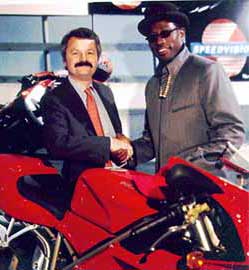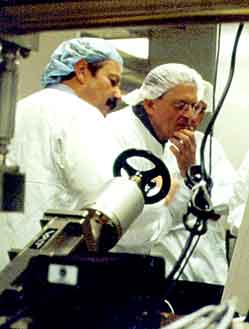Charles Falco
Every once in a while, you meet someone who proves that the worlds of science and art are not intellectual opposites. Charles Falco is such a person. Falco has made a career of blending science, art, and his other passion: motorcycles.

Charles Falco and Wesley Snipes

Charles Falco explaining the operation of one of his Molecular Beam Epitaxy (MBE) machines to David Hockney
Falco is a professor of optical sciences at the University of Arizona. He creates new materials with a process called molecular beam epitaxy, where he heats metals to thousands of degrees in a vacuum chamber, so hot that they turn to vapor. When the metals condense, they can form new types of solids with interesting properties. He has used this method to add extremely thin layers of gold and iridium to a magnetic material such as cobalt, and Motorola, Inc. is now using similar techniques to develop new magnetic memory for computers.
Falco grew up in Des Moines, Iowa. When he was 9 years old, a family friend took him for a ride on a motorcycle. “I was absolutely, totally hooked,” he said. His family then moved to southern California, where people could get a motorcycle license at age 15 ½. Falco bought a motorcycle as soon as he was old enough, which he crashed when he was 15 ¾. “Most people would have learned from their mistake,” Falco said. “I bought another motorcycle.”
Today, he owns 15 motorcycles, and rides regularly. “It provides a nice release for me,” he says. “When you're on a motorcycle you have to pay attention to what you're doing, so you put everything else out of your mind.” Falco also owns a collection of over 3000 motorcycle books.
In 1997, the Guggenheim Museum in New York City, one of the country's premier art museums, contacted Falco. They were planning an exhibition on the art of the motorcycle, and they asked him to help choose which motorcycles to include. It became the most popular industrial design exhibition ever--over 300,000 people saw it in New York. The exhibition has since traveled to Chicago and Bilbao, Spain, while Falco has traveled the country giving lectures on the art and science behind the motorcycle.
In 2000, Falco found a new outlet for his interest in art when he read an article in the New Yorker about British portrait painter David Hockney. Hockney thought that artists as early as the 1400s used lenses to help them paint, 200 years before scientists used lenses. Since then, the two have studied hundreds of paintings, and have given seminars to art historians about their discoveries. Falco used his knowledge of optical physics not only to prove that some artists of the 1400s used lenses, but even to calculate the sizes and shapes of the lenses. “Every art historian who has seen our evidence has left convinced,” Falco said.











